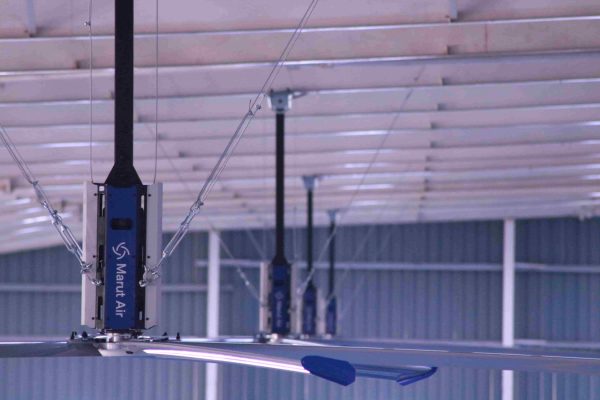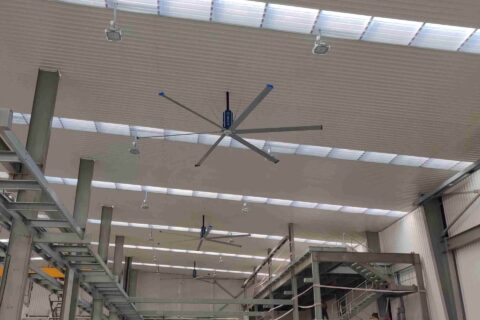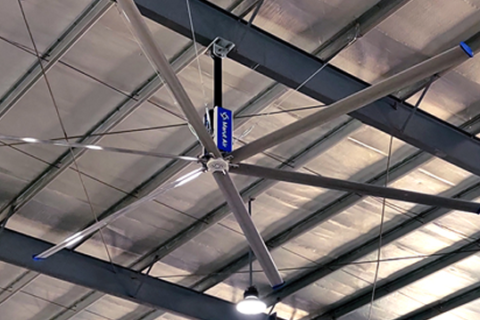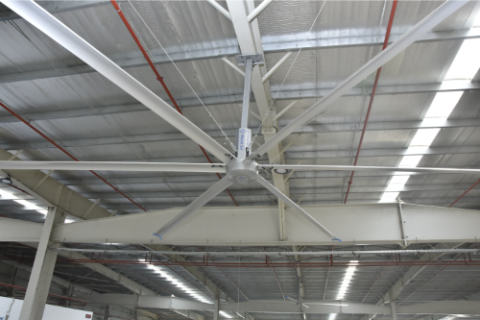High Volume Low Speed (HVLS) fans are increasingly used in commercial and industrial spaces to improve air circulation and maintain comfortable temperatures. These fans are energy-efficient and provide many other benefits, such as reducing energy costs, improving air quality, and enhancing productivity. If you’re planning to buy an HVLS fan, it’s essential to consider the following factors:
Factors Affecting the Cost of HVLS Fans
Size of the space
The space where the HVLS fan will be installed is an essential factor to consider. HVLS fans come in different sizes, and choosing the right size will ensure the fan can circulate air effectively throughout the entire space.
Blade Diameter
An HVLS fan’s blade diameter determines how much air it can move. A larger blade diameter means the fan can circulate air effectively over a larger area. It’s important to choose a blade diameter that is suitable for the size of the space where the fan will be installed.
Motor Efficiency
The motor efficiency of an HVLS fan determines how much energy it consumes. Look for a fan with a high motor efficiency rating, which will help reduce energy costs in the long run.
Noise Levels
Some HVLS fans can produce a considerable amount of noise. Consider a fan with low noise levels if the space where it will be installed requires a quieter environment.
Speed Controls
HVLS fans have different speed control options, including manual and automatic. Choose a fan that offers the speed control option that meets your requirements.
Installation Requirements
Consider the installation requirements of the HVLS fan. Some fans require specific installation procedures that may not be suitable for all spaces. Check with the manufacturer to ensure the installation requirements suit your space.

What is an HVLS Fan and Why is it Important?
HVLS (High Volume Low Speed) fans are large-capacity ceiling fans that have a low motor speed. Designed with sizes from 7 feet to 24 feet in diameter, HVLS fans are designed for air movement in large spaces. Their benefits involve improved comfort, energy savings on heating or cooling, improved air quality and avoiding heat stress by providing a gentle and acceptable overall breeze that stabilizes temperature and reduces humidity.
Why HVLS Fans Are Important
- Energy Savings: HVLS fans significantly reduce energy consumption and costs by improving the effectiveness of the HVAC systems and allowing for higher thermostat settings in summer and efficient heat distribution in winter.
- Improved Occupant Comfort: HVLS fans deliver consistent and gentle airflow, creating an even airflow and a comfortable environment in large spaces.
- Better air quality: Air circulation can help reduce stagnant pockets and increase overall ventilation which is important in maintaining air quality in larger building environments.
- Improved Productivity: Comfortable and well-ventilated spaces yield better employee morale, increased productivity and less heat strain.
- Multiple Uses: HVLS fans can be installed in various large scale environments such as industrial plants, warehouses, manufacturing plants, distribution centers and also agricultural buildings.
What are the Common Mistakes to Avoid When Buying HVLS Fans?
There are several mistakes that you should avoid when buying an HVLS fan, some of which include the following:
- Improper fan size or quantity: Unsuitable fans can cause improper air movement or wasted energy.
- Wrong installation height: If the installation height is improper, the fan won’t perform well, may cause injury, and will not work as designed.
- Poor fan spacing: Multiple fans installed too close together or too far apart means that airflow will be lost or have dead spots or be uneven.
- Poor selection of manufacturer: Poor fans generally require more costly maintenance, are less durable and have poor performance.
- Not studying electrical requirements: Poor sourcing of electrical wiring or not understanding voltage can lead to faulty equipment or irreversible performance-related problems.
- Inaccurate structural requirements: Some fans may be heavy, which is why the built structure must be able to accept the weight of the fan to ensure it is sufficiently safe to install.
Conclusion
In conclusion, HVLS fans are becoming increasingly popular in commercial and industrial spaces due to their energy efficiency and other benefits. When purchasing an HVLS fan, it’s crucial to consider factors such as the size of the space, blade diameter, motor efficiency, noise levels, speed controls, and installation requirements. Marut Air is India’s leading HVLS fan manufacturer that provides high-quality fans suitable for various industries.
Their fans are designed to meet the specific needs of their customers and are energy-efficient, reliable, and durable. Marut Air’s commitment to quality and customer satisfaction has earned them a reputation as a reliable HVLS fan manufacturer in India. If you buy an HVLS fan, consider Marut Air for its high-quality products and excellent customer service.
People Also Ask About the Factors to Look For When Buying an HVLS Fan
Question 1. How do I know what size HVLS fan is right for my space?
Answer. To determine if the HVLS fan is right for your space, you should measure the size (square footage) of your space and find a fan diameter appropriate for that area.
Question 2. Can HVLS fans be used in both commercial and industrial spaces?
Answer. Yes, HVLS fans are designed for both commercial and industrial spaces to improve the comfort and air circulation while lowering energy consumption.
Question 3. Are HVLS fans noisy during operation?
Answer. No, HVLS fans are the energy-efficient solutions that are designed for quiet operation and are significantly quieter than traditional high-speed fans because these fans move a large amount of air at a low speed.
Question 4. Do HVLS fans require special installation or ceiling height requirements?
Answer. Yes, HVLS fans require special installation considerations, including ceiling height, structural support and clearance from obstacles. They are typically installed at a ceiling height of between 12 and 50 feet.





